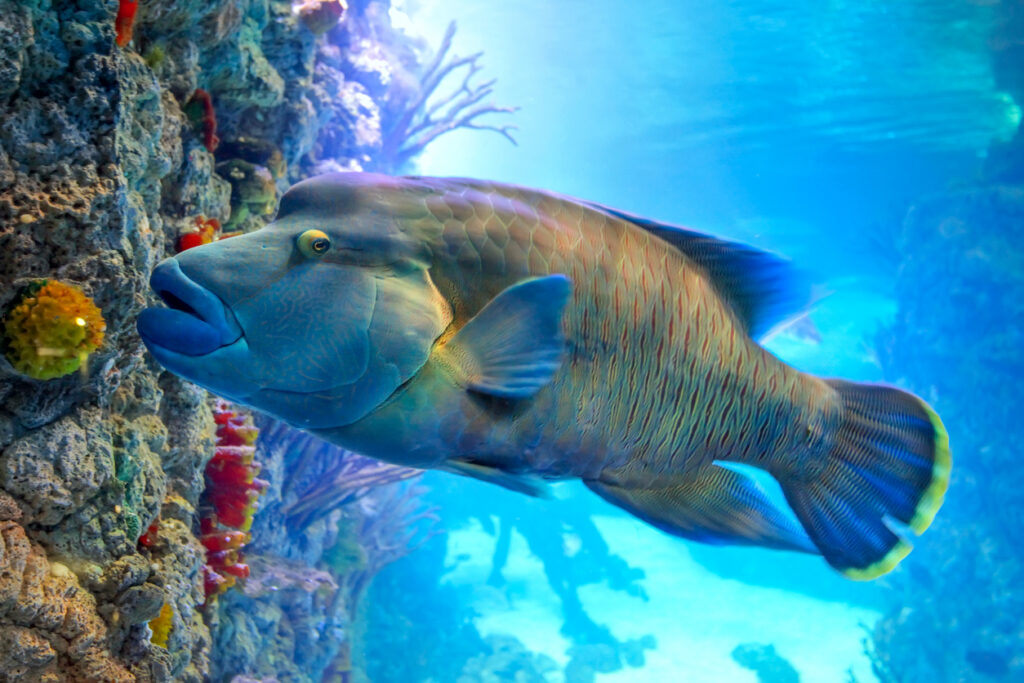Sharks, snakes, rays and seahorses may draw the biggest crowds here at Hastings Aquarium, but we reckon our wrasse deserve a slice of the limelight too. These colourful fish come in many different shapes and sizes, so seeing how many species you can spot in our tanks will certainly keep you occupied during your visit.
To get you in the mood to meet our animals and ensure you have a few facts lined up to impress your friends and family with, in this post, we’ll be taking a look at some of the most interesting things you should know about the humble wrasse. So, without further ado, let’s get to it.
How do you pronounce wrasse?
First things first: the question of how to actually pronounce the name “wrasse”. It’s a term that often trips people up, so if you’re keen to avoid getting egg on your face when sharing these facts with your nearest and dearest, make sure you have the pronunciation nailed down first.
Since the “w” is silent, “wrasse”, as many people may have guessed, is pronounced “rass” like “grass”. It’s not “razz” like “jazz”, but we can see why some people would assume that to be the case since it has an “e” on the end.
So, when planning your visit to Hastings Aquarium, just remember “rass” like “grass”, and you’ll be good to go. Thank us later.
What are the different species of wrasse?
Armed with your new-found knowledge of how to pronounce wrasse, it’s now time to take a deep dive into all the different species that make up this surprisingly large family of fish.
Did you know that there are over 600 species of wrasse in our oceans, categorised into 81 genera? That’s way more than we could possibly fit in our tanks here at Hastings Aquarium, although we have a large collection of wrasse species, with 24 unique animals in total including the ballan wrasse (Labrus bergylta), jade wrasse (Halichoeres chloropterus), and the oddly named twistii wrasse (Anampses twistii) to name but a few.
To make it easier to classify different wrasse species, marine biologists further categorise these fish into nine subgroups, including:
- Cheilines
- Hypsigenyines
- Julidines
- Labrichthyines
- Labrines
- Novaculines
- Pseudocheilines
- Pseudolabrines
- Scarines

6 interesting things to know about wrasse
By now you should be feeling a little more confident about how to pronounce wrasse and the huge number of different species that make up this large family of ocean-dwelling fish. So, with the basics out the way, let’s up the ante by handing over our list of top facts about wrasse that every marine-lover should know.
- Wrasse are recognised by their lips: That’s right – the best way to quickly identify a wrasse from other colourful fish species is by their lips. The scientific name for wrasse Labridae comes from the Latin word Labrum, meaning “lip” or “edge”. So, if you spot any fish in our aquarium that look like they’re puckering up for a kiss, it’s most likely a wrasse.
- Wrasse are found in countless oceans across the world: While the majority of wrasse species are native to warm tropical waters and coral reef systems, the reality is that they’re found in most marine habitats, including the cold waters of the northern Atlantic around the UK. This emphasises just how diverse this family of fish is, and why they’re featured in more than one exhibit here at Hastings Aquarium.
- Wrasse are ray-finned fish: This doesn’t mean they’re shaped like thornbacks and other rays, but it does mean that they’re exceptionally bony, characterised by unique fins that cover their bodies. Indeed, all wrasse are part of the Actinopterygii subclass, which accounts for 50% of all vertebrate fish species in our oceans.
- Wrasse are protogynous hermaphrodites: That’s basically a science-y way of saying that most wrasse species start life as a female but transform into a male at a specific point in their lifecycle. It may sound deeply unusual, but several fish species also exhibit very similar behaviour, including clownfish (Amphiprioninae), groupers (Epinephelinae), and damselfish (Pomacentridae).
- Wrasse have protractile teeth: Along with their impressive lips, wrasse have a noteworthy set of gnashers too. Wrasse teeth are known as “protractile” teeth, which means they’re able to project outwards to better catch passing prey. Trust us: you wouldn’t want to be on the receiving end of a wrasse on the hunt.
- Some wrasse species help support the health of other fish: Not only are wrasse impressive to look at but they play an important role in marine habitats too. This is particularly true of the aptly named cleaner wrasse (Labroides dimidiatus), which feeds on the parasites and dead tissue of other larger fish (yum) – helping to support the health of the broader aquatic ecosystem.
So there you have it, a brief but brilliant introduction to the humble wrasse, one of the most overlooked but interesting residents here at Hastings Aquarium. If you’d like to get acquainted with wrasse along with our full collection of colourful marine critters, tap here to book your next visit to Hastings Aquarium today.
